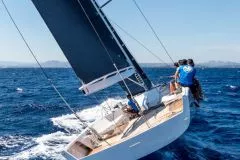New Technologies in Sail Measurement
The marine industry is witnessing unprecedented advancements in sail measurement, changing the way sailors and boat designers approach sail performance and optimization at sea. By utilizing cutting-edge onboard technologies, sailing enthusiasts and professionals can now assess the true shape of sails with greater accuracy, ensuring that every journey is a blend of agility and speed.
Revolutionary LiDAR Technology
In a significant development, two French companies have collaborated to introduce an innovative system that leverages LiDAR technology for real-time sail measurement during navigation. Awarded the name Exocet FlyingShape, this system employs a sophisticated onboard LiDAR device to create accurate three-dimensional reconstructions of sails as they interact with the wind while sailing downwind.
The Challenge of Sail Measurement
Historically, capturing the true geometry of a sail at sea has been a complex task. The dynamics of airflow, material flexibility, and variable sea conditions often hamper traditional assessment methods. The Exocet FlyingShape system solves these challenges by integrating multiple LiDAR sensors that consistently scan and measure the sail’s shape throughout its performance.
Understanding LiDAR Mechanics
LiDAR, which stands for Light Detection and Ranging, utilizes laser pulses to determine distances and create precise representations of objects. Within the Exocet system, these measurements are processed in real time by an onboard computer that computes critical parameters about the sail’s shape, including:
- Trough depth
- Trough position
- Sail twist
Data from this sophisticated monitoring can be analyzed live during sails or reviewed later, providing flexibility for teams and individual sailors alike.
Target Users of the Technology
The Exocet FlyingShape system has been designed with three distinct user groups in mind:
- Racing teams involved in high-stakes regattas (e.g., Imoca, Ultim, TP52)
- Owners of sailing yachts, from small vessels to majestic superyachts
- Marine propulsion projects exploring innovative boat designs and performance enhancements
For each of these categories, the system captures data that can correlate with a vessel’s performance metrics, enabling users to refine their sail and trim adjustments effectively.
Enhancing User Experience with Integrated Systems
One of the most attractive features of the Exocet FlyingShape system is its plug-and-play design, which facilitates seamless integration with existing onboard systems. It works alongside the Pixel sur Mer’s broader EXOCET ecosystem, allowing compatibility with current navigation and data acquisition units. This modular approach means users can adopt the technology without overhauling their current navigation setups, streamlining the transition to more advanced sailing analytics.
Setting the Stage for Continuous Improvement
Beyond live measurements, the system also provides software tools for offline data analysis, giving sailors unique insights into performance trends over multiple navigation campaigns. Traditional sailing practices are evolving to become even more data-driven, enhancing understanding of sail performance well beyond traditional metrics.
Collaboration Driving Innovation
The partnership between MDS and Pixel sur Mer has roots in over two decades of collaboration on projects for major sailing events, such as the America’s Cup. MDS, a spinoff of Benjamin Muyl Design, leads in creating simulation tools and performance prediction attributes, concentrating on aerodynamics and naval architecture. Conversely, Pixel sur Mer specializes in cutting-edge marine electronics, focusing on automation and navigation solutions, combining their expertise to push boundaries in sail measurement technology.
The Implications for Sailing Professionals
With these innovations in sail shape measurement technology, sailing professionals gain an invaluable tool that opens doors to enhanced performance and deeper understanding. The integration of accurate sail data into maneuvering strategies means trimmers can make informed decisions about adjustments that can significantly impact race outcomes. Moreover, naval architects are empowered to refine digital models based on real-world data, resulting in more efficient designs and a competitive edge.
Conclusion: The Future of Sailing Innovations
The advancements in sail measurement through technologies like LiDAR illustrate an exciting leap forward for sailors everywhere. As the nautical world eagerly embraces these innovations, venues for excitement and exploration expand tremendously. Stay ahead of the curve in the sailing realm by utilizing advanced analytics to maximize every trip at sea.
By showcasing how services like GetBoat.com facilitate seamless connections between sailing enthusiasts and the vessels they covet, there’s an encouragement to explore the freedom and adventure of sail rental. The platform underscores the importance of convenience and transparency, allowing users to discover their ideal boat or yacht that aligns with their personal sailing preferences and budget.
As one ventures into new cruising grounds, the opportunity to rent a boat or yacht becomes an essential part of the travel experience. Each bay, inlet, and lagoon offers unique stories about the local culture and environment, making every journey memorable. Exploring these waterways will undoubtedly yield adventures that pique the interest of any keen sailor. For unforgettable experiences on your next voyage, capturing the true essence of sailing is just a click away at موقع GetBoat.com.

 Innovations in Sail Measurement Technology">
Innovations in Sail Measurement Technology">
